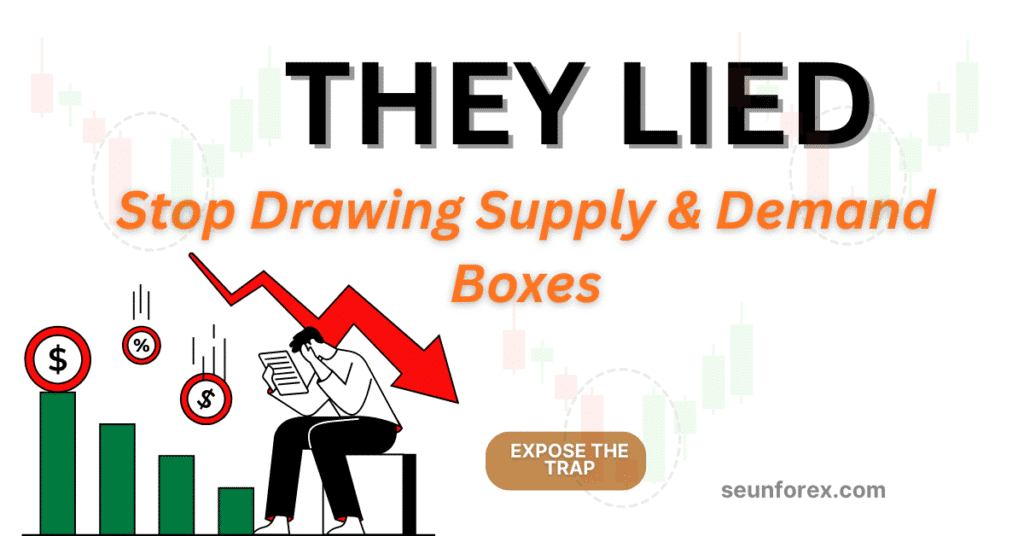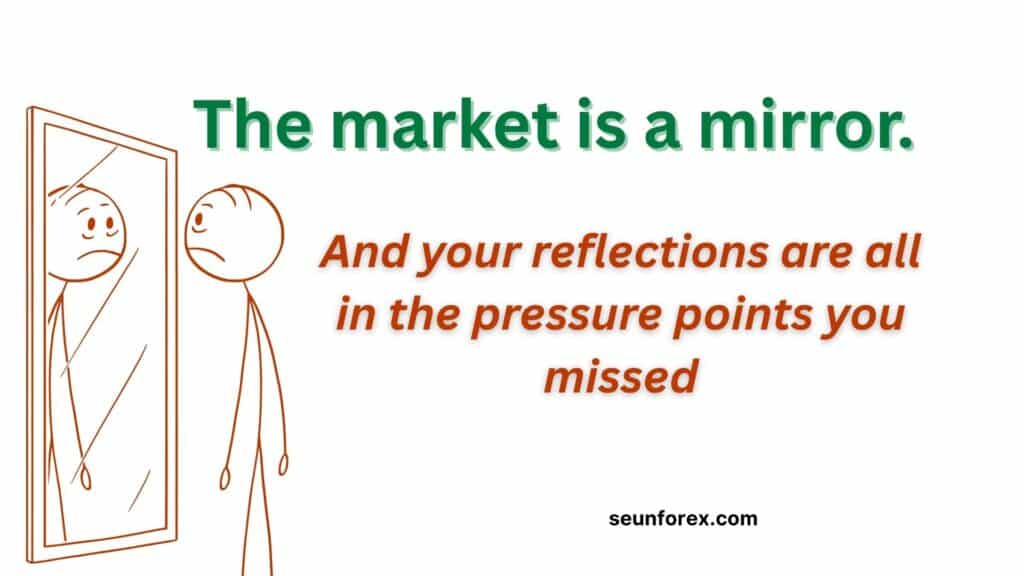
🧠 The Secret Traders Ignore: It’s Not About Patterns — It’s About Pressure
The supply and demand secret isn’t about neat rectangles, candlestick patterns, or magical “supply-demand zones.” Those are just visual aids. The real edge comes from understanding pressure points in human behavior—where the crowd hits a breaking point and where smart money exploits it.
Most traders get lost drawing boxes on charts. They search for confluences, intersections, Fibonacci retracements, or textbook S&D levels. Meanwhile, price doesn’t care about your lines. Price reacts to orders, liquidity, and human psychology.
Ask yourself: have you ever noticed how price reacts to a zone you drew, only to rip through it anyway? That’s the market laughing at your rectangle.
🎯 Why “Boxes” Are a Crutch
Boxes give traders comfort, not clarity. They create a false sense of control. Here’s why:
- Visual bias: Traders believe a price level is “strong” just because they boxed it. Reality? It’s only strong if liquidity and crowd psychology agree.
- Delayed recognition: Waiting for a perfect touch in your box often leaves you behind the real move.
- Overcrowding: If every retail trader trades the same boxes, stop losses become predictable, and the market hunts them ruthlessly.
As Al Brooks once hinted:
“Price doesn’t read charts; traders do. And that’s where the battle begins.”
🧩 The Pressure Principle: Supply & Demand 2.0
Forget textbook supply and demand zones. The supply and demand secret lies in pressure accumulation and release. Here’s what elite traders see that most miss:
The Crowd Reaction – Humans react predictably under stress. A sudden surge in selling or buying pressure creates invisible walls and floors.
The Smart Money Entry – Institutions enter where retail hesitates or panics, capturing maximum liquidity.
The Trigger – The moment when the market exhausts one side of the crowd, and the real move begins.
Think of it like a spring. Retail traders squeeze it into boxes. The market stores potential energy. When it releases, price accelerates—not to your drawn box, but to the nearest unprotected liquidity zone, where smart money can capture maximum opportunity.
📒 Anatomy of a Smart Supply & Demand Trade
Let’s break it down like a Formula 1 pit stop. You want precision, not guesswork.
1. Spotting the True Pressure Points
- Previous High/Low Liquidity Clusters: Look beyond the visible zone. Where did stop losses stack up? Where did buyers/emotionally weak sellers capitulate?
- Acceleration vs. Deceleration: If a move slows as it approaches a retail-heavy box, that’s a warning, not a confirmation.
- Volume Discrepancy: True supply/demand is revealed by who is willing to buy or sell without hesitation at these points.
“Price is a lie detector—it tells the truth about fear, greed, and impatience.”
2. The Pre-Market Plan (Before the Crowd Wakes Up)
This is where your edge begins. Arriving late means you’re fighting everyone else’s mistakes—but understanding the supply and demand secret puts you ahead.
- Entry Logic – Wait for evidence of pressure exhaustion, not a textbook box touch. This is where trading pressure points become visible.
- Stop Placement – Place stops based on order flow vulnerability, not your drawn rectangle. Using behavioral edge ensures your risk aligns with market psychology.
- Targets – Define targets with multiple crowd layers in mind: partial exits where momentum stalls, full exits where liquidity is thin, and potential smart money entry zones.
Tip: Smart traders trade behavior, not boxes—forget the rectangles, focus on behavioral pressure, and let the market tell you where opportunities live.es.
3. The Execution (When Emotions Test You)
Execution reveals the real trader.
- Realized Entry vs. Ideal Entry: Did you hesitate? Did you chase? Journal it.
- Order Size Discipline: Pressure points dictate how much you risk. Too big, and you stress the spring.
- Observation Over Reaction: Watch the market breathe. Every surge or fade is telling a story.
Example:
A supply zone looks “perfect” on your chart. Price approaches. Retail panic sets in. You wait. Price stalls. You enter on the exhaustion wick, not the box. That’s a +3R trade in waiting, while box traders bite dust.
4. Scaling Out (Where Edge Lives)
Forget the all-or-nothing mentality. Elite traders scale into liquidity and scale out into calm.
- First exit: When retail capitulates.
- Second exit: When momentum fades, even if price hasn’t hit your “box.”
- Third exit: Final profit-taking when institutional handoff completes.
“Scaling isn’t cowardice—it’s precision. Every unit sold is a lesson in patience.”
5. Post-Trade Reflection: Pressure, Not Pixels
Your trading journal should track behavioral outcomes, not chart aesthetics. This is where the supply and demand secret truly comes to life:
- Crowd Pressure Assessment – Was the move predictable if you understood trading pressure points?
- Box vs. Behavior – Did your rectangle mislead you, or did you misinterpret the behavioral edge?
- Emotional Feedback – Identify FOMO, hesitation, or overconfidence to improve trader psychology.

By focusing on behavior instead of pixels, you train yourself to spot smart money entry zones and avoid common mistakes like stop loss clusters, turning post-trade reflection into actionable insights.
📊 Monthly Pressure Dashboard
Create your own dashboard to spot patterns in behavior:
- Trades Following Pressure Logic – % of total
- Trades Following Box Logic – % of total (to see wasted attempts)
- Average R per Trade
- Heat Levels vs. Outcome – Did high-stress trades pay off?
- Behavioral Expectancy = (Avg Pressure Win × Win%) – (Avg Loss × Loss%)
If your expectancy is negative when ignoring boxes? Stop drawing rectangles and journal harder.
Discover more from Wall Street Trader
Trading plans, chart patterns, risk management, and investing.
Enter your email…
By subscribing, I agree to Substack’s Terms of Use, and acknowledge its Information Collection Notice and Privacy Policy.
Already have an account? Sign in
🧠 Mapping the Invisible: How Elite Traders Read Pressure Points
The supply and demand secret reveals that boxes fail, and real edge lies in trading pressure points. But how do you actually see the unseen? How do you turn invisible human behavior into measurable, repeatable trading decisions?
It starts with understanding market memory. Price never forgets where liquidity was trapped, where retail capitulated, or where institutions accumulated. Every sharp move leaves footprints—if you know what to look for. Recognizing these patterns gives you a behavioral edge, allowing you to anticipate smart money entry zones and avoid common traps like stop loss clusters.
🎯 Step 1: Identify Liquidity Layers
Think of liquidity layers as the arteries of the market. Where there’s congestion, there’s potential for explosive movement.
- Stop-Loss Clusters – Retail traders love tight stops just beyond obvious zones. When price triggers them, it feeds momentum.
- Previous Highs/Lows – Not just the “box” high/low. Look for levels where hesitation, rejection, or consolidation occurred.
- Thin Areas – Zones where few traders are willing to engage often become fast lanes when approached by smart money.
“Liquidity is the oil; price is the engine. Without the former, the latter stalls.”
Pro Tip: Instead of drawing one rectangle, map multiple micro-zones of pressure. Each one tells a story about crowd behavior.
🧩 Step 2: Time Your Entries Like a Surgeon

The difference between a good trade and a home run isn’t insight—it’s timing. This is the supply and demand secret that elite traders exploit.
The Exhaustion Entry – Wait for the crowd to overextend. Price wicks, slows, or stalls. That’s your opening, where trading pressure points become visible and behavioral edge can be measured.
The Retest Entry – After the initial pressure release, watch for a clean retest of the previous reaction point. Often, the second touch offers better risk/reward and highlights the patterns in trader psychology.
Momentum Confirmation – Use micro candles, volume surges, or tick activity to confirm institutional interest and identify potential smart money entry zones.
Example:
Retail panics at $100. Price drops to $98, wicks back to $99, and stalls. That’s the moment where understanding liquidity layers and human reaction separates a simple trade from a high-probability move. Hesitation tells you: smart money is absorbing, not retreating. Enter here with calculated risk.
📒 Step 3: Risk Management Without Boxes
Forget stop-losses at arbitrary box edges. The supply and demand secret isn’t in rectangles—it’s in behavior-driven stops:
- Behavioral Stops – Place stops beyond behavioral extremes, where retail would capitulate, not just at the edge of your drawn zone. This highlights trading pressure points and institutional liquidity traps.
- Position Sizing – Size positions by stress units: how much capital you’re psychologically comfortable risking on this pressure scenario. This leverages your behavioral edge.
- R Multiples – Always calculate R multiples, not dollar amounts. The move might be big, but your real edge lies in the R ratio, not the nominal profit.
“Smart traders risk the minimum to capture maximum human error,” capturing the essence of smart money entry.
📉 Step 4: Scale Into & Out of Pressure Zones
Scaling is where most traders fail. Boxes encourage rigidity; pressure points demand adaptability.
- Step 1 Entry: Capture the first liquidity release. Half your position.
- Step 2 Entry: Wait for confirmation, add if momentum aligns.
- Partial Exits: Take profits as micro-zones resolve. Don’t wait for your drawn box to be “perfect.”
- Full Exit: Exit when the pressure gradient flattens or another institutional layer absorbs remaining liquidity.
“Scaling is rhythm; all-in is gambling.”
🔍 Step 5: Journal the Pressure, Not the Box
Your journal evolves into a pressure map of human behavior:
- Record psychology triggers (fear spikes, greed surges).
- Track price reactions to pressure layers, not rectangle hits.
- Note execution efficiency: Did you enter early, late, or on confirmation?
- Identify patterns: Are you chasing momentum, fading panic, or trading with crowd absorption?
Monthly Metrics to Track:
- % of trades following pressure logic
- Average R per trade
- Win rate vs. pressure layers
- Emotional heat vs. outcome
- Behavioral expectancy
“The market doesn’t reward perfection—it rewards understanding.”
🧠 Step 6: Build Your Repeatable S&D System
Now that you see pressure, you need a system to repeat it reliably:
- Map Liquidity Layers – Micro and macro zones.
- Define Entry Triggers – Exhaustion, retest, confirmation.
- Set Behavior-Driven Stops – Beyond extremes, not boxes.
- Scale Intelligently – Layer in, layer out.
- Reflect and Adjust – Journal every nuance.
Consistency comes from structure + adaptation, not rigid boxes.
📊 Behavioral Edge Dashboard
Imagine your trading spreadsheet transformed into a behavioral S&D map:
- Pressure Zones Hit – % vs. total trades
- Entry Timing Score – How close to optimal micro-zone
- Exit Discipline – Partial exits vs. full exits
- Emotion Score – FOMO, hesitation, greed
- Net R per Behavioral Pattern – Which psychology traits are profitable
“If you can’t measure human behavior, you can’t trade it. And if you can’t trade it, you can’t win.”
For a deeper dive into how supply and demand affect market behavior, check out this Investopedia article.
Also, learn how to analyze price action without distractions in our internal guide: Naked Trading Charts: Price Action Win.
✅ Key Takeaways
- Forget boxes. Trade behavior, not rectangles.
- Supply & demand is a story of pressure accumulation and release.
- Elite traders map invisible zones, time entries precisely, and scale with intent.
- Journaling is the microscope that reveals your psychological traps and your real edge.
- Systems beat signals. Understand humans, and the rest is just execution.
🎤 Closing Line
Everyone wants the “perfect supply & demand zone,” the “holy indicator,” or the insider trick. But the real secret isn’t on your chart. It’s in the pressure map of human behavior, layered in liquidity, timed with precision, and reflected upon daily.
So the next time someone asks you how to trade S&D like a pro, smile, open your journal, and say:
“I built it myself—by studying the crowd, not boxes.”